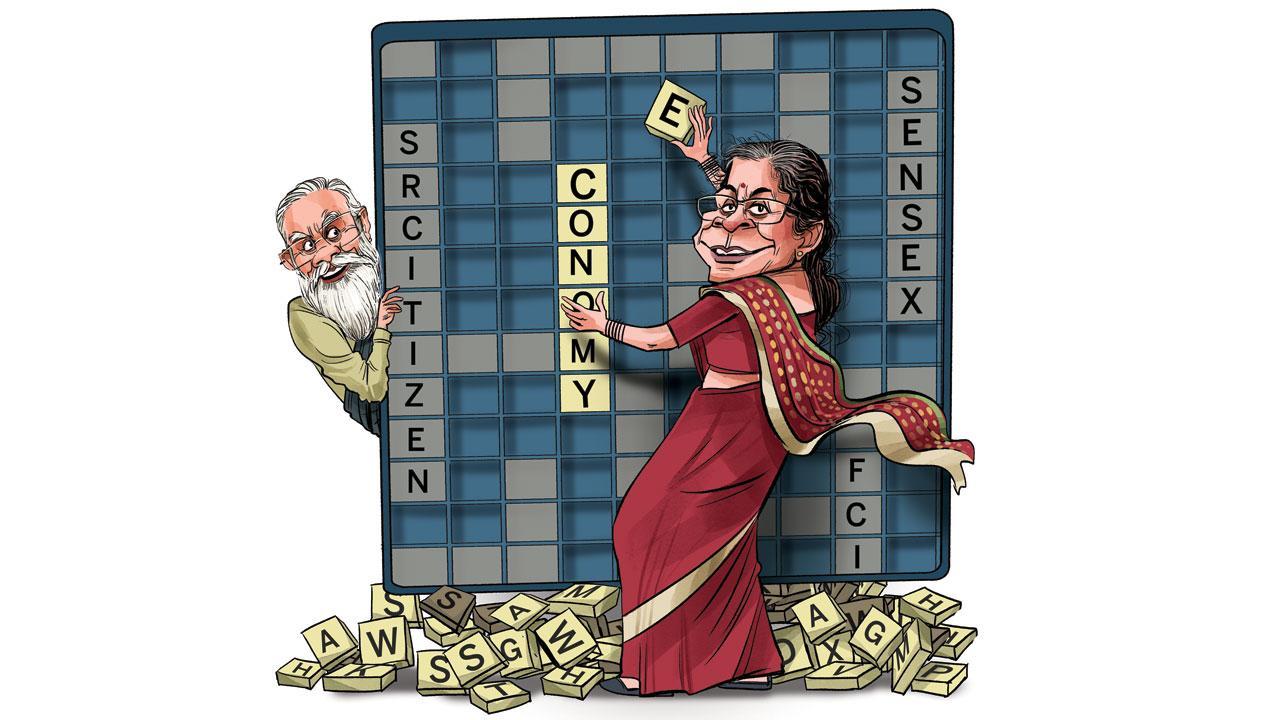The govt has decided to try out several new things on the macro-economic front, while ensuring not to displease the pandemic-hit common man or the retail investor

Illustration/Uday Mohite
In the old days, on a day like yesterday, they would have been dancing in the lanes in and around Dalal Street. It’s a rare occasion when the BSE Sensex rallies by 2,315 points or 5 per cent to close at 48,601 points, on the day of the Union Budget. Of course, these days, thanks to the spread of electronic trading over the years and the COVID pandemic over the last 10 months, most investors had to express their happiness sitting at home, by buying more stocks.
The stock market breathed a collective sigh of relief when it realised that the Finance Minister Nirmala Sitharaman had not re-introduced wealth tax or a one-time COVID cess or increased the capital gains tax on stocks. There was much fear going around in the last few days.
In fact, the Sensex had fallen by almost 8 per cent from a high of 50,184 points touched on January 21 to a recent low of 46,160 points on January 29. Along with some profit booking, the fear that the finance minister might introduce some new taxes in order to finance the government expenditure in 2021-22, had spooked the stock market whole of last week.
But the investors soon realised that no news is good news and stocks rallied big time. In fact, with the benefit of hindsight, it made sense for Sitharaman to not disturb the stock market, given that the government plans to raise Rs 1.75 lakh crore through the selling of its stakes in public sector enterprises and financial institutions, during 2021-22.
The initial public offering of Life Insurance Corporation of India should hit the market next year as well. Along with this, the government hopes to privatise three public sector banks, including IDBI Bank and one general insurance company. It also hopes to sell Air India, BPCL, Shipping Corporation of India, etc. Given this, it didn’t make much sense for the government to spook the market with a new set of taxes.
The tax rates and the tax slabs also stayed the same. The senior citizens who earn only through pension and interest income had something to cheer about. From the next financial year, they no longer need to file an income tax return. This is good news for many retired public sector, central government and state government employees.
Currently, an additional deduction of interest, amounting to Rs 1.5 lakh is available on a home loan taken to purchase an affordable house. This facility has been extended to the next financial year as well, in order to encourage those buying an affordable house.
Over and above this, the finance minister also proposed that if a bank is temporarily unable to fulfil its obligations, the depositors of such a bank can get easy and time-bound access to their deposits to the extent of the deposit insurance cover of Rs 5 lakh. This is not possible currently.
On the macro-economy front, the government has decided to try out several new things. It has decided to start a new developmental financial institution (DFIs) to provide long term financing to the infrastructure sector. India has had several DFIs since independence, including the Industrial Credit and Investment Corporation of India (ICICI), Industrial Development Bank of India (IDBI), etc, in the past. These were done away with in the 1990s.
The government has also decided to launch a bad bank. The idea is to sell bad loans or non-performing assets of public sector banks to the bad bank and help them clean up their books. Bad loans are loans which haven’t been repaid for 90 days or more. It will be interesting to see how well this idea takes off, given that public sector bankers really don’t have much of an incentive to sell bad loans at a discount.
The foreign direct investment allowed in insurance companies has been increased to 74 per cent from the current 49 per cent.
Finally, the truly big reform, in the budget concerns the Food Corporation of India (FCI). The FCI buys rice and wheat directly from farmers on behalf of the government. It then sells it at a very low price through the ration shops to meet the needs of food security. The government allocates a food subsidy in the budget to compensate FCI for this subsidy.
Over the years, the food subsidy allocated has never been enough to compensate FCI totally. The FCI has had to fulfil this difference from other sources, including borrowing money from the National Small Savings Fund, where all the money from small savings schemes ends up.
The government has decided to discontinue this and take on subsidies as a part of its overall expenditure. Due to this, the food subsidies offered to FCI this year have jumped to R3.44 lakh crore against Rs 75,000 crore last year. This has pushed up the fiscal deficit for this year as well as the next year. Fiscal deficit is the difference between what a government earns and what it spends.
Vivek Kaul is the author of Bad Money. Send your feedback to mailbag@mid-day.com
 Subscribe today by clicking the link and stay updated with the latest news!" Click here!
Subscribe today by clicking the link and stay updated with the latest news!" Click here!









